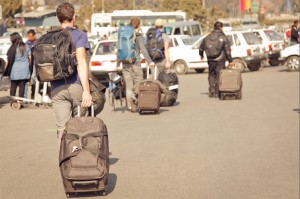A Better Way to Do Short-Term Missions (Part 1)


In less than a week, I’ll be leaving for Nepal, which will be my third “mission trip” to this country. Every year, some buddies and I, who started a ministry called Touch Nepal, head to this impoverished country to help support indigenous pastors. As I recently told a friend of mine, Touch Nepal is probably my favorite ministry I’ve ever been involved in. I’ve also been troubled over the years, however, at the negative consequences that American short-term mission trips have had on the long-term indigenous ministries they seek to serve. What’s even more disheartening is that many people who zealously pursue or advocate for short-term trips never ask the question: How is this going to strengthen the indigenous ministry when I leave? Or: what are the long-term benefits my trip will have on the nationals? Sometimes people even get irritated if you dare question the benefit of short-term trips.
So over the next few posts, I’m not going to argue that we should do away with short-term trips. After all, I’m going on one next week! What I am going to do is offer some reflections on how to pursue short-term missions in a way that actually benefits the indigenous ministries we’re seeking to serve.
The Short-Term Missions (STM) movement has exploded over the past two decades. In 1989, 120,000 American Christians ventured on a Short Term Mission (STM) trip. This increased to 450,000 in 1998, 1 million 2003, and 2.2 million in 2006 (Corbett & Fikkert, When Helping Hurts, 161). At an average cost of $1,500 per trip, this amounts to about 3.3 billion dollars that the church spends on STM per year. And they are short. Ninety-two percent of all STMs are for less than 60 days; more than half are for less than two weeks (Priest & Priest, “They See Everything, and Understand Nothing,” 56).
Most STM trips are sent from the West (esp. North America) to Africa, South America, or Asia. Oftentimes, there could be (and definitely has been) an underlying colonial mindset that fuels the passion of the STM member (conscious or not). That is, we are going to help and save them—those poor people overseas who don’t have the resources, wisdom, and faith that we do. (For a similar perspective, watch this hilarious video on The Onion.) But if we have this mindset, we’re starting off on the wrong foot. It may be helpful to first recognize some basic statistics about global Christianity. Consider the following (See Livermore, Serving with Eyes Wide Open, 31-42, and Jenkins, The New Christendom, 3-9):
• None of the 50 largest churches in the world are in North America. • For every 2 missionaries that come into Nigeria, 5 Nigerian missionaries are sent out. There are currently over 3,700 Nigerian missionaries serving in 50 countries. • 20,000 people convert to Christianity in Africa, 28,000 in China, 35,000 in Latin America—every day. • 40% of South Korea is Christian. • According to the best statistics, 7% of America is Christian. • Christianity is the fastest growing religion in the world, with a 6.9% growth rate (compared to 2.7% for Muslims). Most of this growth is happening in the Majority World (or “Third World”). • By the year 2050, only 1/5 of the world’s Christians will be non-Hispanic whites. • By 2050, there will be an estimated 1 billion Pentecostals in the world, making it the most successful social organization in the past century. Most of these will live in the southern hemisphere (Latin America and Africa).
These facts should reshape the way we think of STMs and missions in general. As missionaries to the non-Western world, we should realize that we’re sending our STMs to places more “reached” than the West. Churches have been established, missionaries (from non-Western nations) are being sent out, and while the form of Christianity may look different than our version in the West—for better or worse—we can’t just give lip service to the fact that we can learn from them; indeed, we need to learn from them and see ourselves as learners, servants, and partners as we come alongside the global church in its mission.
This brings us to our first principle. When we go on an STM trip, we go as servants. We go as learners. We submit our agenda to the mission and ministry that is already happening overseas. We don’t come with some agenda where we pat the cute little third world pastors on the head while we try to show them how to do real ministry. Rather, we ask them: What do you need from us?
Some friends of mine at Eternity Bible College once asked a Spanish Pastor (as in, from Spain) how we could serve him in his ministry. You know what he said? “In my 30 years of ministry, I’ve met a lot of American Christians. And I’ve never been asked that question before.”
30 years of ministry. And he's never been asked by Americans how we could serve him. He's only been told how to do ministry by those in the West who obviously know much more about ministry than he does.
That’s colonialism as its best.
We should go as servants and learners or we shouldn’t go at all. In the next post, I’ll address the dangers of the “Missions for Me” mentality, which is probably the number one reason why people go on STM trips.





